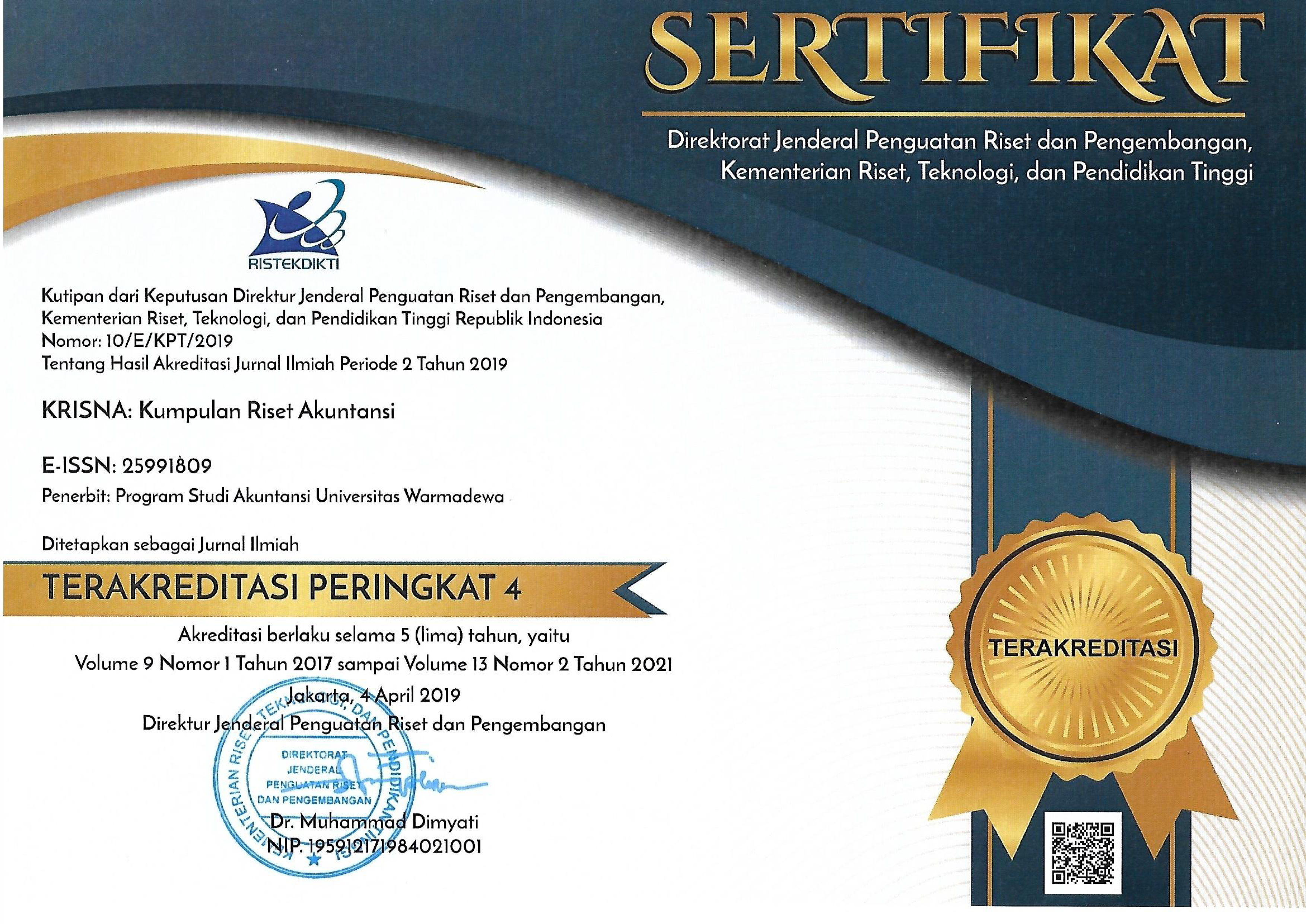KUALITAS NARATIF LAPORAN CORPORATE SOCIAL RESPONSIBILITY: STUDI KORELASI PADA SEKTOR PERBANKAN
Abstract
This study aims to assess the quality of CSR reporting and test the correlation among narrative quality measurements. The Population of the study consists of 29 banks listed on the Stock Exchange (BEI) in 2015. Based on descriptive statistical analysis, the study found that in general the CSR report quality was low, that was shown by the very low value of the mean of optimism ratio, pessimism ratio, numerical ratio, horizon ratio and complexity, and also a readability index that indicate the high level of difficulty of the CSR report to be read. Meanwhile, there are several banks that have presented an excellent report. The results of Spearman correlation test are (1) There is a strong positive correlation between the ratio of optimism and the ratio horizon, (2) There is a fairly strong positive correlation between the ratio of pessimism and numerical ratio, (3) There is a fairly negative strong correlation between the pessimism ratio and numerical ratio, and also between the horizon ratio and the report complexity (residual word), and (5) the other correlations among variables are weak and very weak. Keywords: CSR, narrative reporting quality, and readabilityReferences
Bakar, A.S.A and Ameer, R. 2010. Readability of Corporate Social Responsibility Communication in Malaysia. Article in CSR and Environmental Managemen.Wiley Interscience: www.intersvience.wiley.com. DOI: 10.1002/csr.240.
Baker, H.E dan Kare, D.D. 1992. Relationship Between Annual Report Readability and Corporate Financiai Performance. Management Reseacrh News. Vol. 15. No 4: 1-4.
Barkemeyer, R. 2007. Legitimacy as a Key Driver and Determinant of CSR in Developing Countries. Paper . The 2007 Marie Curie Summer School on Earth System Governance. Amsterdam : 28 May – 06 June 2007.
Beattie, V; McInnes, B, dan Fearnley, S. 2004. A Methodology for Analysing and Evaluating Narratives in Annual Reports: A Comprehensive Descriptive Profile and Metrics for Disclosure Quality Attributes. The Accounting Forum. Vol.28 No 3, 36 – 205.
Bozanic, Z; Roulstone, D.T dan Andrew V. B. 2014. Attributes of Informative Disclosures. Article. Georgetown University: VirginiaAccounting Mini-Conference and a workshop.
Courtis, J. K. 1995. Reability of Annual Report: Western versus Asian Evidence. Accounting, Auditing,and Accountability Journal. Vol 8. No 2, 4-17.
_______.1998. Annual Report Readability Variability: Tests of The Obfuscation Hypothesis. Accounting Auditing and Accountability Journal. Vol 11 No.4, 495-472.
Hasseldine, J., A. I. Salama, dan J. S. Toms. 2005. Quantity Versus Quality: The Impact of Environmental Disclosures on The Reputations of UK Plcs. The British Accounting Review, 37, 231-248.
IASB. 2013. A Review of the Conceptual Framework for Financial Reporting. Discussion Paper.
Kuzey, C., dan A. Uyar. 2017. Determinants of Sustainability Reporting and Its Impact on Firm Value: Evidence from The Emerging Market of Turkey. Journal of Cleaner Production, 143, 27-39.
Laidroo, Laivi dan Oobik, Urmas. 2013. Banks' CSR disclosures – headquarters versus subsidiaries. Baltic Journal of Management. Vol. 9. No. 1, 47 - 70
Loughran, T dan Mcdonald, B. 2011. When a Liability Not a Liability? Textual Analysis, Dictionaries, and 10-Ks. The Journal of Fiannce. Vol. LXVI. No.1, 35 – 65.
Merkl-Davies, D dan Brennan, N. 2007. Discretionary disclosure Strategies in Corporate Narrative: incremental Information or Impression Management. Joournal of Accounting Literature. Vol. 26 (January), 94 – 116.
Mutlu, S; Radhakrishnan; dan A.Tsang. 2013. Measuring Corporate Social Responsibility Report Quality Using Narratives. Working Paper. Sloan School of Management.
Peraturan Pemerintah Republik Indonesia Nomor 47 Tahun 2012 tentang Tanggung Jawab Sosial dan Lingkungan Perseroan Terbatas.
Richards, Glenn dan Chris van Staden. 2015. The Readability Impact of International Financial Reporting Standards. Pacific Accounting Review. Vol. 27. No. 3. P. 282-303.
Satari, S; Pitt, Leyland, T; dan Caruana, L. 2011. How Readable Are Mission Statements? An Exploratory Study. Corporate Communication: An International Journal.Vol. 16. No. 4, 282-292.
Tekfi, Chaffai. 1987. Readability Formula: An Overview. Jurnal of Documentation. Vol. 43. No. 3: 261- 273.
Sharma, B. 2013. Contextualising CSR in Asia: Corporate Social Responsibility in Asian Economies Singapore: the Lien Centre for Social Innovation
Shu, K.T. 2012. The Advertising Effects of Corporate Social Responsibility on Corporate Reputation and Brand Equity: Evidence from the Life Insurance Industry in Taiwan. J Bus Ethics. Vol. 109:189–201
Smith, Malcolm; Yinan Dong; dan Yun Ren. 2011. The Predictictive Ability of Corporate Narrative Disclosures: Australian Evidence. Asian Review of Accounting. Vol 19. N0 2.p. 157-170.
Undang-undang Republik Indonesia Nomor 40 Tahun 2007 tentang Perseroan Terbatas.
Visser, W., D. Matten, M. Pohl, dan N. Tolhurst. 2007. The A to Z of Corporate Social Responsibility A Complete Reference Guide to Concepts Codes and Organisations. Whest Sussex: John Wiley & Sons.
 Abstract viewed = 219 times
Abstract viewed = 219 times
 PDF (Bahasa Indonesia) downloaded = 423 times
PDF (Bahasa Indonesia) downloaded = 423 times









